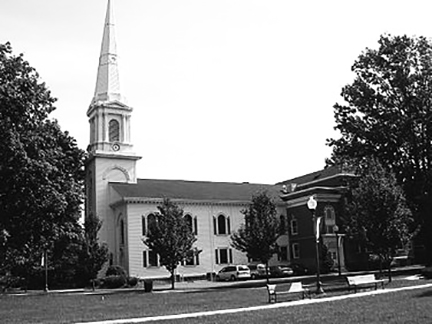By Dan Shine
Voice Columnist
Four Centuries of West Haven Green
Part Four
See – Part 1, Part 2, Part 3, Part 5, Part 6, Part 7 or Part 8
This is the fourth in a series that will touch on the 400-plus year history of West Haven’s Green-
Today there are summer concerts and fall fairs on the West Haven Green. Two hundred years ago, there was the meetinghouse. A symbol of West Haven’s arrival as a community, the meetinghouse stood approximately where the First Congregational Church now stands. Only the original building served as a multi-purpose center: church, lecture hall, and social setting where families met each Sunday to share the news and teens flirted.

Every other a month, all able-bodied men ages 16–60 were expected to show up on the Green with a working musket, sword, powder, and shot. Anyone found deficient was fined, as in the case of three West Haveners. What might seem humorous today was a life-and-death issue in early West Haven. By 1760, West Haveners had suffered through five colonial wars. So being in a state of perpetual readiness became a way of life. It also would eventually collide with Great Britian’s beliefs that the American militia was nothing more than a motley crew of ill-trained farmers. That kind of imperial thinking was bound to cause trouble down the road.
Still, militia training days on the West Haven Green became a mix of muster and frivolity. From military drills and cudgel contests to broad jumping, turkey shoots, and games for everyone, these training days took on a festival atmosphere.
But not everyone was happy. After losing its first two ministers to Episcopacy, West Haven’s First Congregational Church soon had a rival neighbor. In 1740, a number of West Haven Anglican families donated land adjacent to the Green. By 1742, an Episcopal chapel and graveyard now stood in the very shadows of the Congregational meetinghouse. Making matters even worse, a succession of foreign-trained Episcopal clergymen at the new church made more enemies than converts among Anglicans and Congregationalists alike. They may have had their religious differences, but West Haveners sadly shared a deep bias against outsiders.
Not until 1767 when the Rev. Bela Hubbard, a Guilford native, assumed the pulpit did Christ Church finally find its spiritual anchor. It came not a moment too soon. A number of its West Haveners were already holding protests on the Green against the British, and some openly spoke of a revolution that would rid the troubled village of both King and his dreaded Episcopal church.
(To be continued.)
Peter J. Malia is the author of Visible Saints, West Haven, Connecticut, 1648-1798, available at www.connecticutpress.com, Barnes and Noble.com, ebay. com, and Amazon.com.